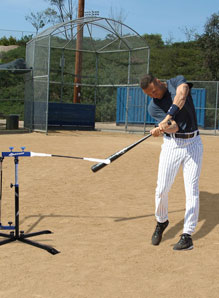Baseball Batting Practice Techniques
By Guest Author: Jacob Bennet
There are some key things to follow when standing at home plate ready to swing away. However, before you start swinging at the very first pitch, its important to understand the following. Your mindset, proper footing, body stance, arm positioning, bat positioning, hip placement, neck and head and swing follow through. This may sound like a lot of batting practice steps to follow and for youngsters to understand, but you'd be surprised at how much they will pay attention, if you can almost guarantee them, they'll hit the ball.
Your batter's mindset is important and further instilled during your prior week's baseball hitting training drills. Unlike practice, they will face some stink-eye from the pitcher and usually a big-mouth degrading comments from the catcher, in hopes to try to confuse your batter. Your batter will need to have a solid understanding of the steps mentioned above (we'll go through each one in more detail), so that their confidence is high, both from the confidence from your voice and encouragement and more importantly from the repetition of successful ball contact during prior batting practice.
When your batter stands up to the home plate, you want to have them initially obtain proper footing and spread their legs, the rear leg behind the plate, and the other covering two-thirds covering home plate. This stance should be about shoulder width and comfortable to your batter, with both feet pointing forward and not towards the pitcher or catcher. This isn't their end stance as will be mentioned in a minute, but for now when they first walk up to the plate to bat, have them stand with their feet spread about shoulder width apart.
Standing at the plate during batting practice, you'll want your batter to bend their knees a few 3-5 times, to make sure they are not stiff, and feel a bit flexible. Bending their knees a few times will also add to helping them feel comfortable and in charge. Their body above the torso should be mostly straight up and down, with an ever-so-slight curve forward over the plate.
If they are right-handed, their left side should be facing the pitcher, with their right grip above the left grip when holding the bat. Likewise, if they are left-handed, they should have their right shoulder facing the pitcher and their left grip above the right, again when holding the bat. As a side note, but extremely important, make sure they follow these steps during both batting practice as well as during each game.
As a right hand batter, their right elbow should be placed almost level with their right shoulder, in other words, as they lift up the bat, their right fist should be level with their right elbow which should be level with their right shoulder. By focusing on forming a level horizontal "V" shape, this will help ensure their elbow is held high and does not droop down.
With the proper elbow placement, the bat (for a right-hand batter) should be angled forward at about a 10:00 o-clock position. Don't let your batter start off batting practice with the bat drooping down or even at a 9:00 angle, rather 10:00 - 10:30 bat positioning is best for the soon to be swing and follow through.
To recap thus far, the feet should be spread apart, toes pointing perpendicular to the pitcher and catcher line-up. Bring the bat back to about ten o'clock with the elbow up and level with their fist and shoulder. Now have them twist back, or "cock" or wind up their hips back away from the pitcher.
Make sure during batting practice that they bring back the forward foot so that it's just a couple of inches from the rear foot, still remaining parallel to each other. And don't let them deviate during game day.
Now have your batter look that pitcher into the eye and be ready to follow their pitching arm letting go of the ball and do not let them take their eye off the ball. And as they stare down the ball coming towards them, have them step out with their forward foot, un-wind their hips and swing their bat as hard as they can and point their forward foot towards the direction they want to hit the ball.
Following these above mentioned steps during your weekly or daily batting practice, will help ensure a less timid and more confident team on game day.
Jacob Bennet is a father of 4 boys and loves to coach his son's baseball teams. His reviews of various team sports equipment including various types of batting cages, pitching machines and even likes to share his expertise on batting practice techniques. He is eager to help both players and coaches make good sound decisions when searching for specific baseball supplies and even the less fun, but more important baseball supplies like pitching machines, batting cages along with the best ways to create and experience an effective practice for your team.
Article Source: http://EzineArticles.com/?expert=Jacob_Bennet
Article Source: http://EzineArticles.com/7515092
======================
Derek Jeter Hurricane Hitting Machine by SKLZ
Welcome to the Hurricane Hitting Machine Blog for Baseball Coaches, Players and Parents. Our daily posts can help you get the most out of your baseball drills and team practices. Our free baseball articles, baseball coaching tips, and baseball drills can help your baseball player or baseball team improve. Our archive has hundreds of articles related to baseball training and baseball practice.
Sunday, August 18, 2013
Subscribe to:
Posts (Atom)

